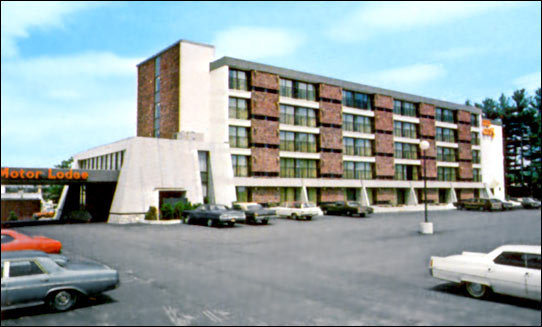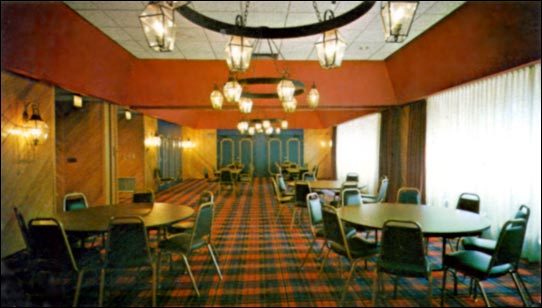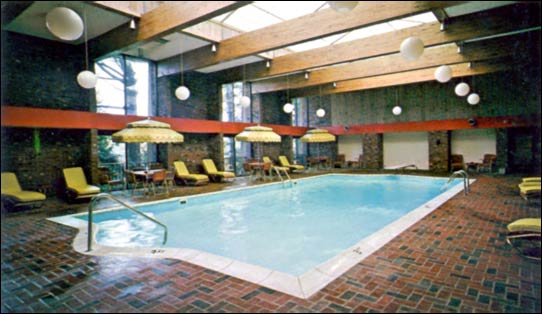| |
| Postcard
ca. 1970s: Kummerlowe Archive |
|
| |
Manchester,
New Hampshire -- 298 Queen City Blvd. |
| |
Having
begun in 1959 as a Nims-type Restaurant only, the Howard Johnson's
Manchester site became a complete complex when in 1972 its adjacent
ultra-modern five story high-rise Motor Lodge was opened. Featuring
100+ standardized guest rooms, meeting rooms, saunas, indoor heated
pool, and an exercise room, the Motor Lodge's exterior was "1970s
modern" with its prominent blocky angled concrete yet softened
by sections of exposed natural brick. Ahead of its time, Manchester's
Motor Lodge foretold the future of highway hostelry function and
layout! The Motor Lodge relinquished its Howard Johnson identity
in early 1997, and was converted into a Comfort
Inn . .
Below:
The property diagram shows Manchester's ground level. Note that
the Nims-type Restaurant faced Daniel Webster Highway and was
not oriented to 2nd Street like the Motor Lodge. The Restaurant
itself is no longer extant.
|
|
| |
| Borchure
ca 1980s: Dan Donahue |
|
| |
The
following commentary is provided by Nate Coggeshall-Beyea who has
extensively studied and documented the history and development of
Howard Johnson's in New Hampshire:
Located at
298 Queen City Boulevard, the Manchester HJ represented New Hampshire’s
only restaurant and high-rise motor lodge unit. High-rise motor
lodges were becoming more and more common within the HJ empire
by the early 1960s, especially in high-traffic urban areas where
demand for overnight accommodations was significant. As New Hampshire’s
premiere city, Manchester seemed a logical choice for one of these
larger motor lodge units. Likewise, Queen City Boulevard, the
main route through the heart of downtown Manchester, was an ideal
roadway selection for a HJ complex, offering it excellent visibility
and thus steady patronage. Queen City Boulevard was U.S. Route
3 as well as Manchester’s central artery. All motorists
traveling in and out of the city passed over this road during
their excursions. Therefore, it quickly became the focal point
of roadside and streetside commerce inside Manchester.
Running parallel
to Queen City Boulevard and also through the center of the city
was Interstate 293, a new superhighway that branched off from
I-93 just north of the city and rejoined it again just south of
the city (I-93 followed the outskirts of Manchester, whereas I-293
offered drivers passage directly through the city). I-293 and
Queen City Boulevard (Route 3) interchanged at an area known locally
as the Queen City Bridge, located at the south end of Manchester.
Given the shear volume of traffic flowing over both of these roads,
the Queen City Bridge interchange was one of the largest crossroads
in Manchester and perhaps all of New Hampshire. True to form,
it is here, at this busy intersection and amidst the merging and
converging of motorists, that HJ opened its new high-rise establishment
in 1972.
The Manchester
restaurant began operations around 1960, with its first known
directory listing in that year. Although the exact architectural
style of Manchester is unknown (due to substantial altering in
later years), it seems probable that this location originally
featured a Nims Two type restaurant. Located to the left, the
restaurant was connected directly to the later built motor lodge,
with an indoor corridor between the two facilities.
The Manchester
HJ was owned and operated by the same interests that managed the
motor lodge in Portsmouth
and later took over operation of the adjacent restaurant there.
Manchester was a very profitable franchise for HJ and its owners,
retaining the HJ moniker well into the 1990s. This can be tied
directly to its outstanding location in a high-travel city, clearly
the ideal environment for an HJ. Rather than ever displacing it,
the Manchester store worked in tandem with the Hooksett
store to corner the Manchester market from both the north and
the south. These two HJs maintained a tight grip on the area for
many years.
The Manchester motor lodge was one of the last three HJ entities
to operate in New Hampshire, standing firm against the shifting
tides along with Portsmouth
and Nashua.
But alas, by the late 1990s, HJ was gone from Manchester, giving
way to increasing competition and other business pressures.
|
|
| |
| |
| Postcard
ca. 1970s: Kummerlowe Archive |
|
| |
| |
| |
| |
| |
|
| |
The
purpose of this site is informational. It is neither commercial
nor representative of any brand, company, or business. Trade names,
trademarks, etc. that are depicted remain the property of their
respective owners. Please contact this site's owner
prior to reproducing any part of it. Works from contributors (includes
photographs, ephemera, etc.) must not be reproduced without their
explicit consent. |
|
| |



